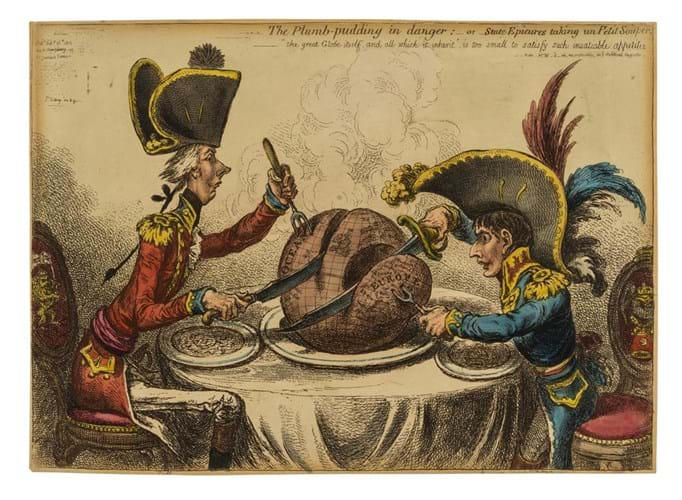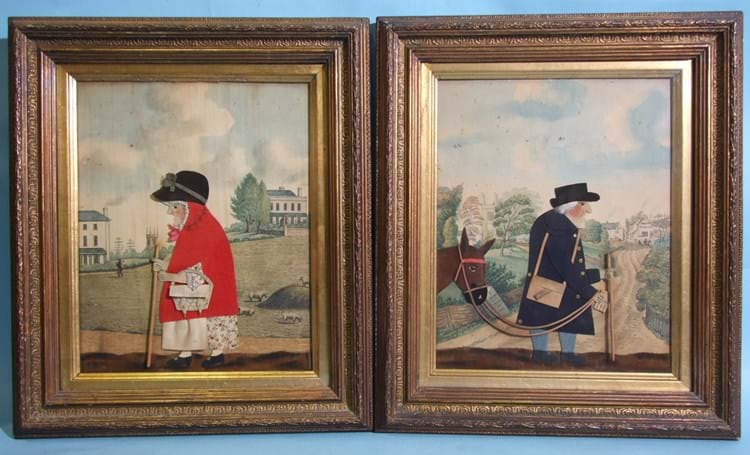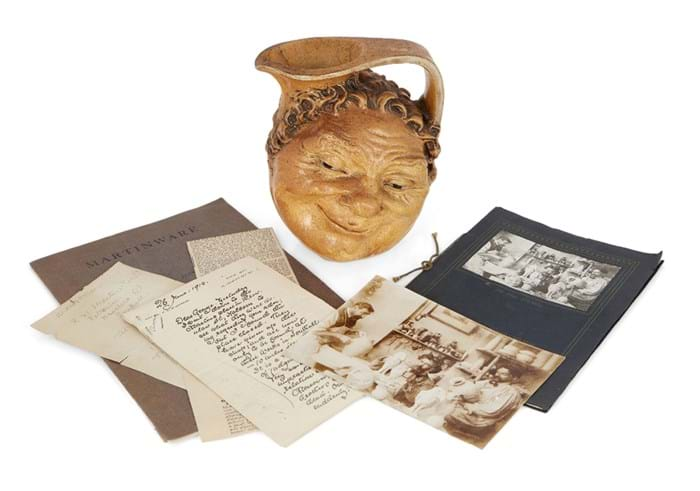1. George Smart folk art pictures – £8000
At Frant there dwells a Man of fame. By trade a Tailor, Smart by name.
A pair of pictures by folk art favourite George Smart (1774-1846) sold for £8000 at Eldreds in Plymouth on November 29. The felt and watercolour collages, each measuring 11 x 13in (28 x 33cm) in gilt gesso frames with maker’s labels, depicted two of his most popular subjects: Old Bright, The Postman, and The Goosewoman (Elizabeth Horn). Smart, who styled himself ‘Cat Manufacturer, Artist in Cloth & Velvet Figures and Professor of Peculiar Art’, used the leftover scraps from his tailoring to produce these playful images of village life in Frant, near Turnbridge Wells.
The pictures, accompanied by verses such as the one that opened this tale, were popular souvenirs for early 19th century tourists. The Smart workshop is mentioned in guidebooks at the time and (as referenced in the labels to the back of these pictures) received the patronage of the patronage of His Royal Highness, the Duke of Sussex.
This pair, which came from a Plymouth deceased estate with an earlier provenance to dealer Bill Foxsmith, were guided at £3000- 4000 but went to the specialist trade bidding on the phone, at twice the top estimate.
Auctioneer Anthony Eldred credited their ‘bright and cheerful’ condition and “unusually strong colours”.
2. Martinware character jug – £3200
Part of the appeal of the Martin Brothers is the back story – eccentric characters, a less-than-commercial approach to production and a sometimes unpredictable output. Anything that adds to their story will also add value.
The Design Since 1860 sale at Roseberys London on December 7 included a RW Martin & Brothers double-sided character jug that came with some remarkable documentation.
The 6in (15cm) jug, dated 1903, was consigned for sale by descent from Australian collector George Swinburne who purchased it directly from the studio at Southall in 1914 through his agent, Rev WG Beardmore.
Alongside two early 20th century Martin Bros brochures is a letter from Beardmore dated June 26, 1914 in which he laments recent changes at the Martin studio and the recent closure of its Holborn shop.
He writes: “They are very unworldly and unpractical men in relation to business. Moreover, two of the brothers are now dead. One died very suddenly; and unfortunately with him died some of the most important secrets of the production. The eldest one (Wallace) is fairly well but getting old. He is the one who makes the face jugs. But I fear they will never again do work equal to that of the former days.” Estimated at £2500-3500, the lot took a satisfactory £3200.
3. James Gillray caricature – £8500

The Plumb-pudding in danger or State Epicures taking un Petit Souper by James Gillray – £8500 at Forum Auctions.
Plumb-pudding in danger or State Epicures taking un Petit Souper is the most famous of all James Gillray’s satirical caricatures and perhaps the most well-known of all Georgian political cartoons.
Published by Hannah Humphrey in 1805, Napoleon Bonaparte and William Pitt face each other across a steaming ‘plum-pudding’ globe, both intent on carving themselves a substantial portion of the world.
This copy, trimmed to or just within the platemark with some toning to extremities of the sheet and minor spotting, had a guide of £6000-8000 at Forum Auctions in London on December 1. It sold at £8500.
Although one took a record £15,000 back in 2013 at Bloomsbury Auctions, a more recent comparison is the copy sold as part of the Arthur Gilbert collection of Gillray prints at Bonhams in 2020 made £7000
4. George Romney portrait – £30,000

A portrait of Mrs Daniel Wilson of Dallam Tower by George Romney – €33,000 (£30,000) at Schloss Ahlden.
The sale at Schloss Ahlden in Lower Saxony on December 2 included this early work by the English portrait painter George Romney (1734-1802). According to information on the original frame the sitter is the 72-year-old Mrs Daniel Wilson of Dallam Tower.
Although far removed from the artist’s ‘prime period’ images of Emma Hamilton and the most fashionable members of Georgian society, the Wilson family were among Romney’s most important patrons in his formative years. The Lancastrian artist, who was born in Dalton-in-Furness and died in Kendal, made his reputation painting portraits of the Lakeland gentry. Working from studio in Kendal, the artist could count the Wilsons of Dallam Tower and the Stricklands of Sizergh Castle as his best clients before his move to London in 1762.
This picture in Germany was dated 1760. Daniel Wilson (1680-1754) was a Whig politician who sat in the Commons for a total of 34 years as MP for Westmorland between 1708-47. His wife Katherine, depicted here in her widow’s weeds, was the daughter of Sir Daniel Fleming of Rydal Hall, another Westmorland politician.
The relined canvas, measuring 76 x 56cm, was guided at just €1500-3000 but found its audience, selling at an online bidder at €33,000 (£30,000).
5. Roman dodecahedron – £33,000
Roman dodecahedrons – handheld bronze or copper alloy objects cast with 12 flat pentagonal faces and ball finials to the 20 vertices – continue to baffle after more than two-and-a-half centuries of study.
Since one was found as part of a coin hoard in England and discussed by the Society of Antiquaries in 1739, more than 100 others have been unearthed at sites across northern Europe. Archaeological context dates them to the 1st to 5th centuries.
But what were they for? As no mention of dodecahedrons has been found in written or pictorial accounts, their use is entirely speculative. There are books and websites dedicated to the subject. Were they, as various theorists suggest, a type of rangefinder or surveying instrument, an astronomical calendar, a tool for determining the optimal sowing date for winter grain, a ‘masterpiece’ object made to show bronze casting skills or simply children’s toys?
Certainly, given that a number have been found in coin hoards, they were much valued and valuable objects. Perhaps most convincing – given that most dodecahedra have been found in Britain, Germany and France and none in the Southern or Eastern reaches of the Roman empire – are hypotheses that argue they had a cultural significance for the peoples in the formerly Gallic regions of northern Europe. Perhaps they were used in Gallo-Romano rituals or fortune-telling?
What we do now know is how much a Roman dodecahedron might bring on the open market. The example offered at Wilkinson’s in Doncaster on December 3 measured 3½in (9 cm) making it one of the larger known. The 116 recorded examples range in size from 4 to 11cm across.
No information regarding its provenance was included in the catalogue but, estimated at £800-1200, it took £33,000.
6. Thai banknote design – £12,000
This Thailand 10 Baht note appears to be a printer’s design that was unissued. Although very similar to the 1902 note by The Government of Siam, there are some differences – the most obvious being that the issued note was brown on a yellow underprint and this note is grey on green. The centre text and the two lower signature areas are also variants. The note, with the serial number A/1 00000 and a wholly blank verso was entered for sale at Lockdales in Ipswich on December 3 by a vendor who used to work for the banknote printer Thomas de la Rue.
It was estimated at just £100-150 but attracted huge interest among Thai banknote collectors before selling at £12,000.









